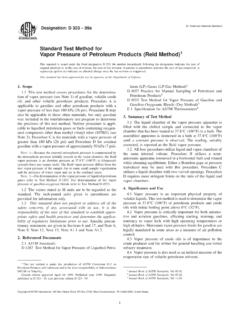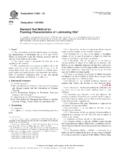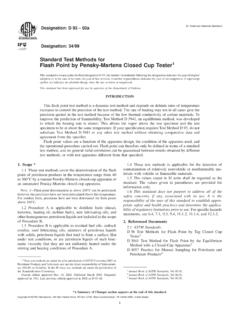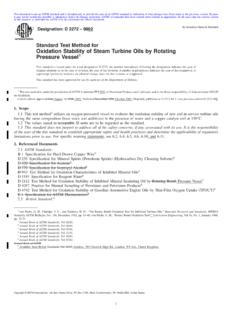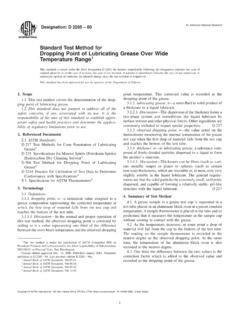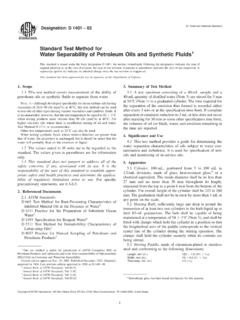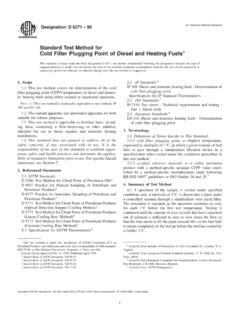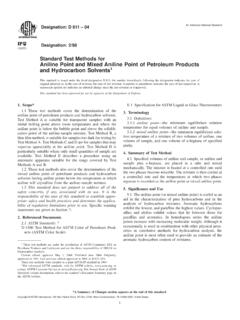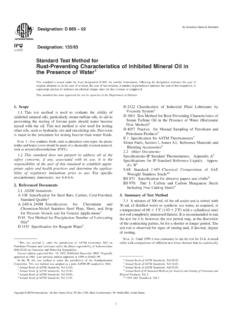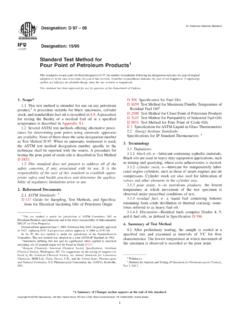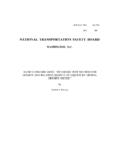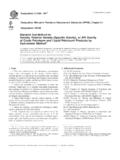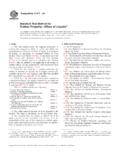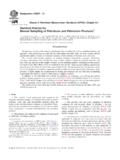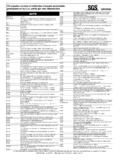Transcription of Standard Test Method for Oxidation Stability of …
1 Designation: D 2440 99 Standard Test Method forOxidation Stability of mineral insulating Oil1 This Standard is issued under the fixed designation D 2440; the number immediately following the designation indicates the year oforiginal adoption or, in the case of revision, the year of last revision. A number in parentheses indicates the year of last reapproval. Asuperscript epsilon (e) indicates an editorial change since the last revision or Standard has been approved for use by agencies of the Department of This test Method determines the resistance of mineraltransformer oils to Oxidation under prescribed acceleratedaging conditions. Oxidation Stability is measured by thepropensity of oils to form sludge and acid products duringoxidation. This test Method is applicable to new oils, bothuninhibited and inhibited, but is not well defined for used orreclaimed A shorter duration Oxidation test for evaluation of inhibitedoils is available in Test Method D For those interested in the measurement of volatile acidity,reference is made to the work of IEC Subcommittee The values stated in metric units are to be regarded asthe Standard does not purport to address all of thesafety concerns, if any, associated with its use.
2 It is theresponsibility of the user of this Standard to establish appro-priate safety and health practices and determine the applica-bility of regulatory limitations prior to Referenced standards :B 1 Specification for Hard-Drawn Copper Wire3D 664 Test Method for Acid Number of Petroleum Productsby Potentiometric Titration4D 974 Test Method for Acid and Base Number by Col-orIndicator Titration4D 2112 Test Method for Oxidation Stability of InhibitedMineral insulating Oil by Rotating Bomb5D 2272 Test Method for Oxidation Stability of Steam Tur-bine Oils by Rotating Pressure Vessel4D 3487 Specification for mineral insulating Oil Used inElectrical Publication:CEI/IFC 61125: 1992 Unused Hydrocarbon Based Insulat-ing Liquids Test methods for Evaluating the OxidationStability63. Summary of Test A test specimen of mineral transformer oil is oxidized ata bath temperature of 110 C, in the presence of a coppercatalyst coil, by bubbling oxygen through duplicate test speci-mens for 72 and 164 h, respectively.
3 The oil is evaluated at theend of each aging period by measuring the amount of sludgeand acid formed. The test specimen is diluted withn-heptaneand the solution filtered to remove the sludge. The sludge isdried and weighed. The sludge-free solution is titrated at roomtemperature with Standard alcoholic base to the end pointindicated by the color change (green-brown) of the addedp-naphthol-benzein Significance and The Oxidation Stability test of mineral transformer oils isa Method for assessing the amount of sludge and acid productsformed in a transformer oil when the oil is tested underprescribed conditions. Good Oxidation Stability is necessary inorder to maximize the service life of the oil by minimizing theformation of sludge and acid. Oils that meet the requirementsspecified for this test in Specification D 3487 tend to minimizeelectrical conduction, ensure acceptable heat transfer, andpreserve system life. There is no proven correlation betweenperformance in this test and performance in service, since thetest does not model the whole insulation system (oil, paper,enamel, wire).
4 However, the test can be used as a control testfor evaluating Oxidation inhibitors and to check the consistencyof Oxidation Stability of production ( Oxidation ) Bath An oil bath, wax bath, oraluminum block heater (see IEC Standard 61125) of a suitabletype capable of controlling the temperature at Cwith a temperature gradient of less than 1 C in the body of theliquid. Use any nontoxic liquid having low volatility at 110 Cand containing no volatile additives and having a flash pointabove the test temperature. mineral oils, waxes and silicone1 This test Method is under the jurisdiction of ASTM Committee D-27 onElectrical insulating Liquids and Gases and is the direct responsibility of Subcom-mittee on Chemical edition approved May 10, 1999. Published August 1999. Originallypublished as D 2440 65 T. Last previous edition D 2440 Research Report No. RR: D-27-1001, available from ASTM Headquar-ters, 100 Barr Harbor Drive, West Conshohocken, PA Book of ASTM standards , Vol Book of ASTM standards , Vol Book of ASTM standards , Vol Electrotechnical Commission.
5 Available from American NationalStandards Institute, 1430 Broadway, New York, NY ASTM, 100 Barr Harbor Drive, West Conshohocken, PA 19428-2959, United have been used satisfactorily. Circulation of the oil or waxheating medium by means of a pump or stirrer is recom-mended. See also , relating to the depth of fluid in agingbath and position of oil Tower A drying tower 25 to 30 cm in height,fitted with a ground-glass stopper and side tubes for condition-ing of the oxygen Receptacle and Head An oil receptacle consistingof a heat-resistant glass test tube 25 mm in outside diameter, mm in wall thickness, 210 mm in overall length includinga Standard taper 24/40 outer joint, with a Dreschsel-type headconsisting of a Standard taper 24/40 inner joint with side outlettube mm in outside diameter and an oxygen delivery mm in outside diameter and 3 mm, minimum, in insidediameter which extends to within mm of the bottomof the oil receptacle and has its end ground at an angle of 30 to the axis of the tube.
6 The design is shown in Fig. Position the oil receptacle in the aging bath in accor-dance with the drawing shown in Fig. The oil receptacle and position in the aging bath are essen-tially the same as specified in IEC Standard 61125, Test Method forOxidation Stability of Inhibited mineral insulating Oils, Glasswaredimensions have been altered slightly to conform to sizes readily availablein the United Crucibles A glass filter crucible having amaximum diameter of the pores between 5 and 15 m asdetermined in accordance with the Method described in theAppendix. Cellulose ester type membrane filters of 5- mporosity have been used successfully Reagents and of Reagents Use reagent grade chemicals in alltests. Unless otherwise indicated, all reagents are to conform tothe specifications of the Committee on Analytical Reagents ofthe American Chemical Society, where such specifications , cp, oracetone, ,8for dilution of the oxidized oil, precipita-tion, and washing of the sludge shall conform to the followingrequirements:Relative Density at 20 to index at 20 to temperature, min, C % shall distill between C.
7 Temperature rise between 20 and80 % recovery shall be C Indicator Solution The specifica-tions forp-naphtholbenzein are prescribed in Test MethodD a solution containing 10 gp-naphtholbenzeinper litre of titration solvent (see ). Obtained from liquid oxygen, minimum pu-rity %. Hydroxide Solution, Standard Alcoholic ( ) Prepare alcoholic potassium hydroxide solution and stan-dardize as described in Test Method D 974. Commerciallyprepared Alcoholic Potassium Hydroxide Solution is Solvent Mix 3 parts by volume of toluenewith 2 parts by volume of isopropyl Carbide Abrasive Cloth, 100-grit with Catalyst AWG No. 18 ( ( )diameter) % purity conforming to Specification B copper wire of equivalent grade may also be Acid, 10 Volume %.7. Consult Material Safety Data Sheets for all materialsused in this test Preparation of Oxygen Oxidize the oil by contact with oxygen of %minimum purity conditioned as Use metal or glass tubing to deliver the oxygen to theoxygen delivery tube.
8 Eliminate rubber connections if used, the rubber should be at room temperature. Limit thelength of rubber tubing exposed to the oxygen flow to 13 not use rubber connections in contact with the liquid of theheating bath or under conditions where the temperature of therubber will be above room temperature. Where it is necessaryto use rubber connections, only sulfur-free rubber is permis-sible. FOA/USP Nalgene tubing has been found satisfactory inthis Dry the oxygen by forcing it through a solid desiccant7 Reagent Chemicals, American Chemical Society Specifications, Am. Chemi-cal Soc., Washington, DC. For suggestions on the testing of reagents not listed bythe American Chemical Society, see Reagent Chemicals and standards , by JosephRosin, D. Van Nostrand Co., Inc., New York, NY, and the United StatesPharmacopeia. 8A suitable material is ASTMn-Heptane Knock Test Reference Fuel, marketedby the Phillips Petroleum Co., Bartlesville, conforming to the specifications indicated is availablefrom Distillation Products Industries, Eastman Organic Chemicals Dept.
9 , Rochester3, 1 Oil Receptacle and HeadD 24402of high moisture-absorbing the desiccant inthe drying tower to a depth of 205 to 254 mm. Change thedesiccant when the indicator begins to change colors frommoisture absorption. If an indicator is not used, change thedesiccant at least After passing oxygen through the drying tower, admitit directly to the receptacle containing the oil to be tested. Donot preheat the Determine the rate of oxygen supply with an elec-tronic flow meter, calibrated rotameter, or soap bubble buret,and adjust the flow rate to deliver the conditioned oxygen at arate of L/h to each tube of oil being Preparation of Oil Wash each oil receptacle thoroughly, first with acetoneand then with soap and water, and rinse in acid solution. Thefollowing reagents have been found suitable: chromic acid,aqua regia, and ammonium each receptaclefree of acid, using tap water, and finally rinse with distilledwater.
10 Dry in an oven at 105 to 110 C for at least 3 h, cool toroom temperature in a desiccator, and keep the receptacle in thedesiccator until ready for Preparation of Copper Immediately before use, polish the copper wire withsilicon carbide abrasive cloth and wipe free of abrasive with aclean dry Wind a 300-mm length of the polished wire into ahelical coil approximately 16 mm in outside diameter and 50mm in height. Clean the coil thoroughly with chloroform oracetone, air dry, and insert immediately into the oil the clean copper coil only with clean tongs to Commercially available, prepackaged, preformed coilsthat meet the requirements described in this test Method may beused as an alternative Method of catalyst preparation. Clean thecoil in a 10 % HCl solution for 30 s, rinse three times with tapwater and with distilled water, chloroform or acetone and airdry immediately before use. Preformed coils were used in a1997 Round Robin Study and found suitable for this Preparation of Glass Filtering Clean the glass filtering crucible and dry in an air ovenat 105 to 110 C until it has reached constant mass.
